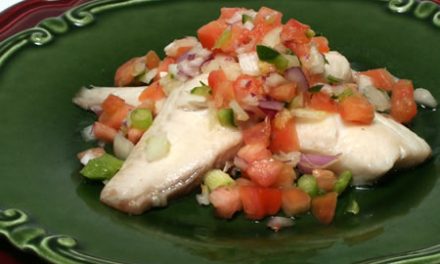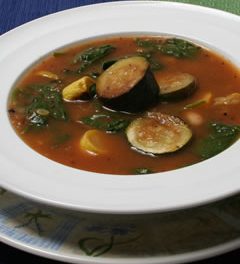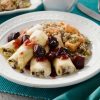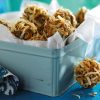This is the ultimate guide to planning a healthy, happy Thanksgiving. From turkey selection and meal planning, to prep work and tips to make life easier on Thanksgiving day. This year may just be the year to hone your holiday cooking and party planning skills!
Instead of relying on grocery store prepared foods or catering companies to supplement your holiday meal, consider the money that can be saved by selecting some great diabetic Thanksgiving recipes with a well defined timetable of tasks.
This planning guide starts a few weeks before the holiday feast. Your food budget will be rewarded and your guests will truly savor a traditional Thanksgiving meal (or you can try some more unique Thanksgiving recipes.
Four to three weeks ahead:
- Prepare the guest list and ask everyone to RSVP at least two weeks before Thanksgiving.
- Find out if your guests have special dietary requirements.
- If extra tables, chairs, glasses or dinnerware will be needed, ask family, friends or neighbors if you might borrow the items for the day. Or find the best value with a rental company and place your order.
Two weeks ahead:
- Decide on the final menu and collect all recipes. To avoid an overloaded oven or range top, select a few recipes that taste good at room temperature.
- If it is the custom in your family, ask your guests if they would like to bring an appetizer, side dish or dessert. Assign cooking projects to family members who offer to help.
- If you are preparing most of the food yourself, consider a few foods that freeze well such as appetizers, cake or cooapple okies.
- Order a fresh turkey or buy a frozen turkey and place it in the freezer (read Turkey Purchasing Pointers). If buying a whole turkey, plan on one pound per person. If purchasing a bone-in turkey breast, plan on 3/4 pound per person. For a boneless turkey breast, calculate 1/2 pound per person. These formulas allow plenty of leftovers to enjoy sandwiches, soups, stews and other family favorites.
- Purchase alcohol and other beverages or delegate this activity to the non-cooking guests. Calculate that each wine bottle contains about five glasses of wine. Consider serving sparking cider to guests who do not drink alcohol. Plan on beverages for the children. Other non-alcoholic drinks could include iced tea, soft drinks (sugar-free for diabetic guests) and flavored water.
- Check the local newspaper and web sites for holiday food coupons and grocery store bargains.
- Prepare two shopping lists: one for perishables and one for non-perishables. Check the ingredients you have on-hand and verify the shelf life for dried herbs and spices are not expired.
- Shop for non-perishable products. Ingredients for desserts and side dishes can be purchased before the holiday rush. Purchase such non-perishable products as flour, sugars and sweeteners, dried herbs and spices, canned pumpkin (or make your own pumpkin puree), packaged stuffing and cornbread mixes, rice, and fresh or frozen cranberries.
- If you plan to deep-fry, smoke or grill the turkey, check the outdoor equipment to make sure it is in working order. Plan an alternative cooking method just in case there is inclement weather on Thanksgiving Day. Purchase the oil, wood chips or charcoal now, before supplies are scarce.
- This is a good time to toss any out-dated foods in your refrigerator. You will need to make room for the holiday ingredients, so along with cleaning out the shelves, give the refrigerator a good cleaning.
- Plan the type of table centerpieces to be used — floral, fruit or candles — and determine what needs to be purchased.
- If necessary, wash and iron table linens and polish silver.
- Find the turkey roaster and rack (read The Right Roasting Pan for Turkey). Check to make sure the food thermometer is in good working order. Check your inventory for cotton kitchen twine, a turkey baster and a fat separator for making gravy.
One week ahead:
- Shop for hardy vegetables such as onions, winter squash, carrots, potatoes, parsnips and turnips (read: Fall Produce Guide: What’s in Season, Nutritional Info and Diabetic Recipes to Try.).
- Buy heavy cream now as it may be hard to find right before Thanksgiving.
- Clean the turkey platter and other serving dishes. Use post-it notes to define the foods to be placed in each serving platter and bowl.
- Calculate how long it will take the turkey to thaw. This is the easy formula: for each 4-1/2 pounds of frozen turkey, plan on a 24-hour refrigerator thaw time. For example, if the turkey weighs 16 pounds, the refrigerated thaw time will be 3-1/2 days. Place the frozen turkey, in the original wrapper, in a 2-inch deep roasting pan. Thaw the turkey, with the breast side down so the juices will flow into the breast. A thawed turkey may remain in the refrigerator for 1 to 2 days. Plan accordingly.
- Start making extra ice for the beverages.
Three days ahead:
- Clean the house.
- If you are using fresh flowers or fruits for the table arrangements, they should be purchased today and the table arrangements assembled.
Two days ahead:
- Make pumpkin pie, pumpkin cheesecake, cookies, rolls and breads or cornbread for the turkey gravy or stuffing. Refrigerate desserts with custard-like ingredients. (The desserts may be brought to room temperature before serving.) Even if you are serving apple or pecan pies, the pie crust could be made today with assembly and baking late tomorrow.
- Prepare menu items such as cranberry sauce, soups, appetizer dips and other items that improve in flavor as they are held in the refrigerator.
- Assemble casseroles (such as sweet potato or green bean); they can be stored uncooked in the refrigerator and baked on Thanksgiving Day.
- If you are making homemade stuffing, cut and cube bread and place it in a single layer on a baking pan to dry.
“Saute Wednesday” or One Day Ahead:
- Set the tables – both the dining table and the buffet table. Arrange the chairs. When setting the table, be sure to remember the salt and pepper shakers, butter plate and all the serving utensils.
- Set up a coat rack with extra hangers. If rain or snow is forecasted, be sure there is a space for umbrellas.
- Buy the salad greens and perishable vegetables. Wash leafy greens, spin, dry, and store by packing in paper towels in a sealable plastic bag in the refrigerator.
- Wash, trim and cut fresh vegetables. Wrap in damp paper towels and place in sealable plastic bags in the refrigerator.
- Prepare garnishes and wrap them in damp paper towels and place in sealable plastic bags in the refrigerator. Label the garnishes for their intended uses so a volunteer kitchen helper can help with the final plating of the foods.
- If you ordered a fresh turkey, pick it up from the store.
- Cook the turkey broth with the turkey giblets and wing tips. The broth will be a great flavor enhancer with the stuffing/dressing and gravy.
- Set up the beverage bar with the necessary napkins and glasses.
- Chill beverages. If the refrigerator space is limited, chill the beverages in an ice cooler.
- Bake fresh sweet potatoes so they will be ready for the final recipe preparation tomorrow.
- Complete any remaining baking, such as apple or pecan pies. Cover and store fruit pies at room temperature.
- Calculate the turkey cooking time and temperatures (plus cooking order) for tomorrow.
- Delegate some party tasks such as taking coats, serving drinks and helping with outside cooking.
- Make sure the turkey is thawed completely before you go to bed for the night.
Thanksgiving AKA “Turkey Day”
First tasks of the day:
- Prepare stuffing for the turkey and/or the dressing to cook in a baking dish. If you choose to stuff the turkey, stuff loosely, allowing about 3/4 cup of stuffing per pound of turkey. As soon as the turkey is stuffed, place it in a preheated 325F oven.
- Prepare the beverage garnishes (lime wedges, lemon twists and olives) cover and refrigerate.
- If the table arrangements are based on fresh fruit, assemble the centerpieces.
- Prepare the cleaned vegetables for cooking – peel and chop. Cover the ready-to-cook vegetables and put them in the refrigerator.
- Boil and mash potatoes; they can be reheated just before serving. Consider holding the warm mashed potatoes in a slow cooker. They will stay warm and creamy up to two hours. Or make mock mashed potatoes instead using cauliflower.
Second tasks of the day:
- An hour before the turkey is done, begin cooking fresh vegetables and get other foods ready to go into the oven (stuffing, rolls, etc.)
- Open red wines so the wine can breathe.
- Put the butter on the table so it will soften.
- Prepare the relish tray. Cover and return to the refrigerator.
- Use a food thermometer to check the internal temperature of the turkey and dressing. A whole turkey should be cooked to a minimum internal temperature of 165F throughout the bird. Most home cooks enjoy the dark meat at a higher internal temperature of 175F to 180F. Check the internal temperature in the innermost part of the thigh and wing and the thickest part of the breast. The stuffing should reach 165F, whether cooked inside the bird or in a separate baking dish.
While the cooked turkey is resting:
- Put a foil tent over the turkey and allow the turkey to rest for 20-25 minutes before carving begins.
- Bake casserole dishes of stuffing/dressing in the preheated oven.
- Warm other foods – including mashed potatoes, soups, casseroles and rolls.
- Remove cold desserts from the refrigerator to allow them to come to room temperature.
- Cook frozen vegetables.
- Ask a volunteer to fill the water glasses.
- Make the gravy and preheat the gravy bowl with hot water so the gravy will stay hot.
- Place all the food on the table or buffet. Ask for volunteers to help with last minute preparation such as opening white wine and placing foods in warm serving bowls.
- Be thankful you are surrounded by family and friends on this most American of holidays.

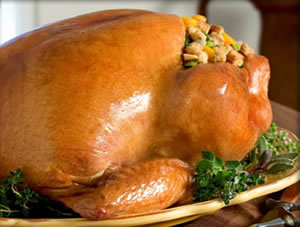

 Spicy Buffalo-Style Meatballs
Spicy Buffalo-Style Meatballs Apple Oatmeal Raisin Cookies
Apple Oatmeal Raisin Cookies
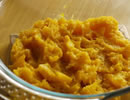 Make Homemade Pumpkin Puree
Make Homemade Pumpkin Puree Fall Produce Guide
Fall Produce Guide Reduced Sugar Apple Pie Recipe
Reduced Sugar Apple Pie Recipe Pumpkin Cheesecake
Pumpkin Cheesecake Cornbread and Dried Fruit Dressing
Cornbread and Dried Fruit Dressing Porcini Mushroom Gravy
Porcini Mushroom Gravy

